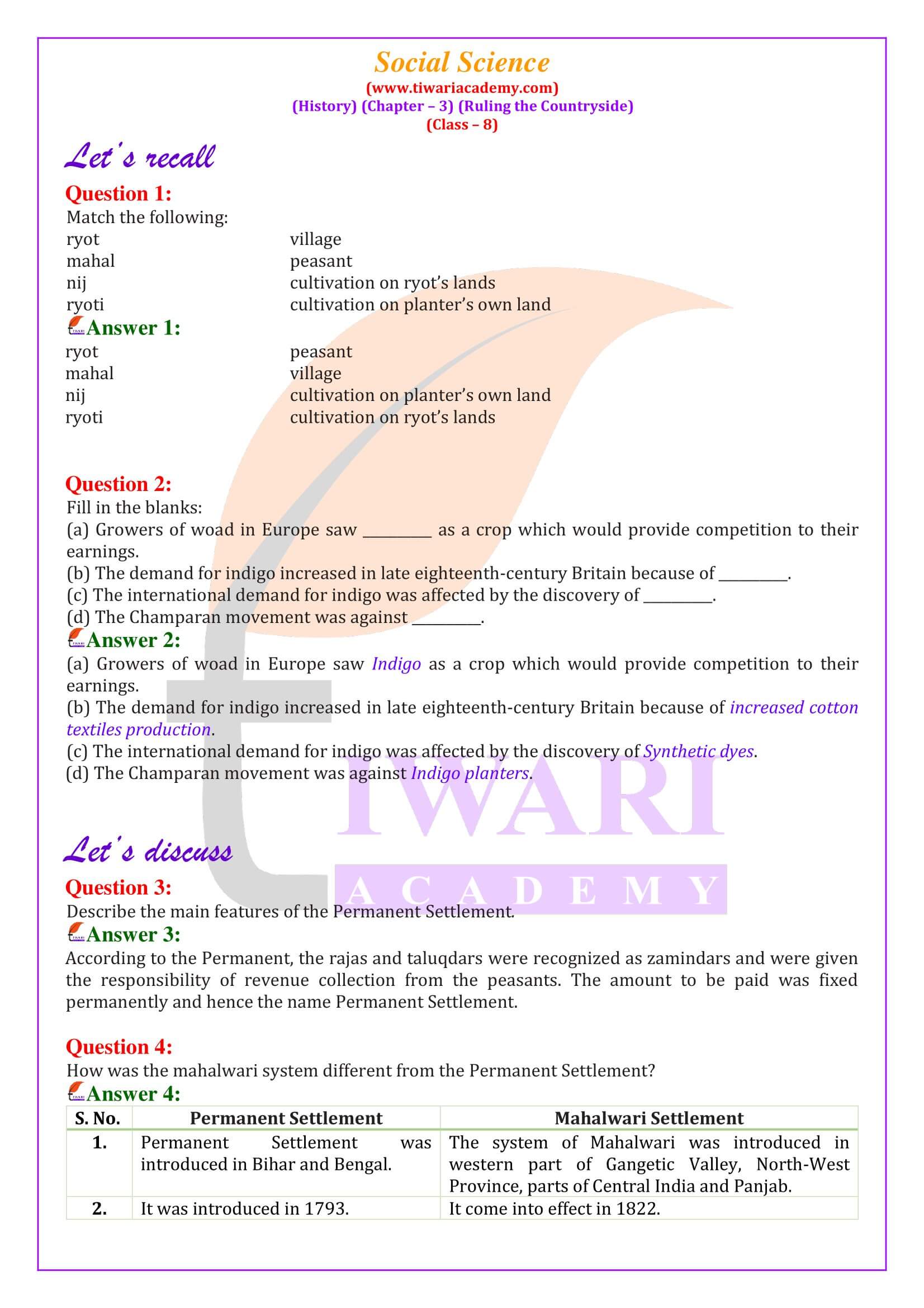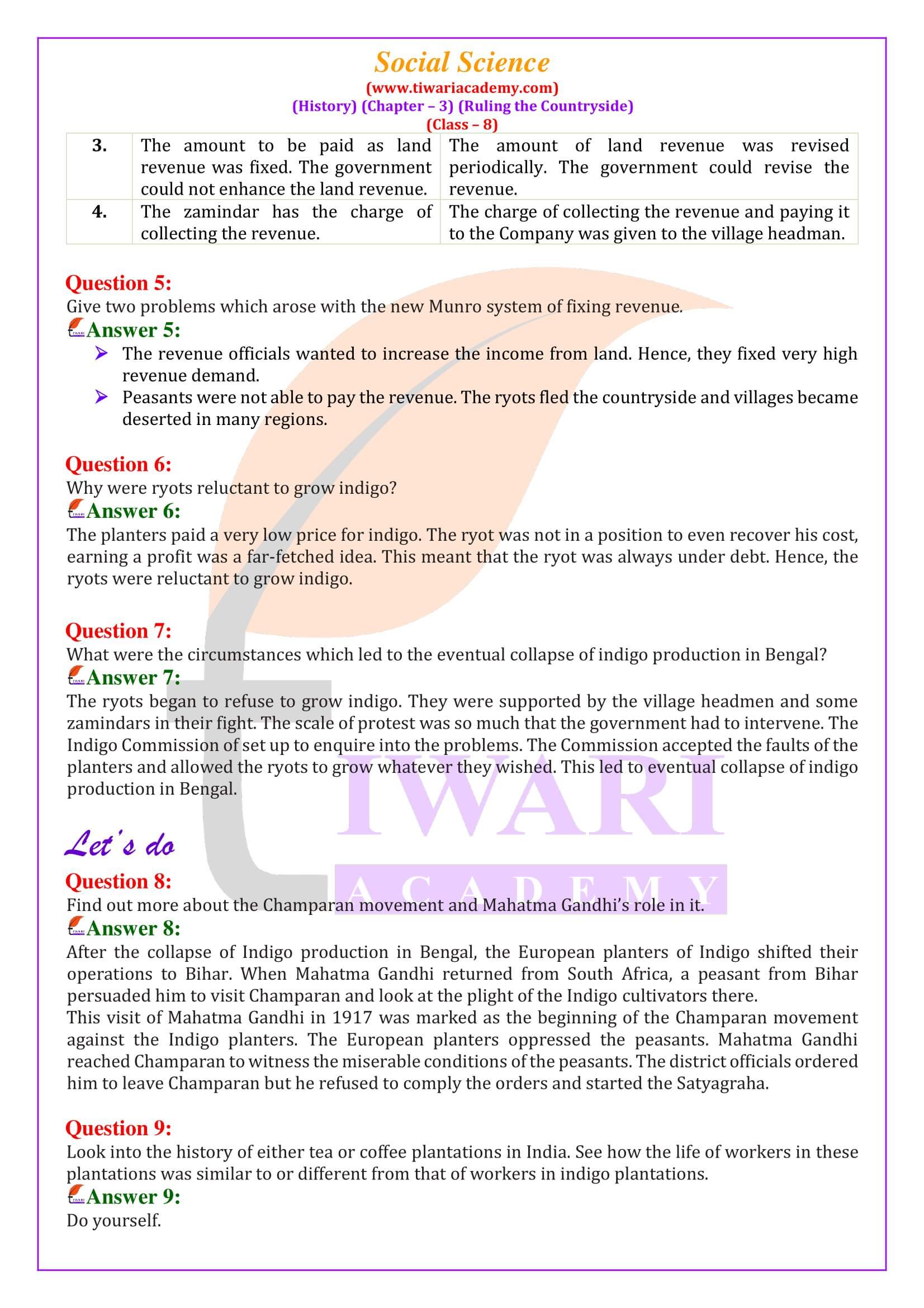NCERT Solutions for Class 8 Social Science History Chapter 3 Ruling the Countryside in Hindi and English Medium revised and updated for academic session 2024-25. The question answers of class 8 History chapter 3 are modified according to new NCERT books issued for 2024-25 exams.
NCERT Solutions for Class 8 Social Science History Chapter 3
Download NCERT Solutions 2024-25 along with NCERT Books for other subjects also. Now discussion forum is open for all, so ASK YOUR QUESTIONS here. This the platform for sharing the knowledge with each others.
Class 8 History Chapter 3 Extra Questions
Describe the Revenue for the Company?
The Company had become the Diwan, but it still saw itself primarily as a trader. The effort was to increase the revenue as much as it could and buy fine cotton and silk cloth as cheaply as possible. Before 1865, the Company had purchased goods in India by importing gold and silver from Britain. Now the revenue collected in Bengal could finance the purchase of goods for export. Soon it was clear that the Bengal economy was facing a deep crisis. Peasants were unable to pay the dues that were being demanded from them. Artisanal production was in decline and agricultural cultivation showed signs of collapse. Then in 1770 a terrible famine killed ten million people in Bengal.
What was the need to improve agriculture?
Most Company officials began to feel that investment in land had to be encouraged and agriculture had to be improved. After two decades of debate on the question, the Company finally introduced the Permanent Settlement in 1793. By the terms of the settlement, the rajas and taluqdars were recognised as zamindars. They were asked to collect rent from the peasants and pay revenue to the Company. It was felt that this would ensure a regular flow of revenue into the Company’s coffers and at the same time encourage the zamindars to invest in improving the land. Since the revenue demand of the state would not be increased, the zamindar would benefit from increased production from the land.
Class 8 History Chapter 3 Question Answers
CBSE NCERT Solutions for Class 8 Social Science History Chapter 3 Ruling the Countryside is given below for session 2024-25. Visit to Discussion Forum to ask your doubts and reply to the questions asked by others. All the Offline apps are free to use just like updated NCERT Solutions 2024-25 on Tiwari Academy.
| Class: 8 | Social Science |
| Subject: | History |
| Chapter 3: | Ruling the Countryside |
| Content Type: | Text and Images Online |
| Session: | CBSE 2024-25 |
Important Questions on 8th History Chapter 3
Fill in the blank: Growers of woad in Europe saw __________ as a crop which would provide competition to their earnings.
Growers of woad in Europe saw Indigo as a crop which would provide competition to their earnings.
Describe the main features of the Permanent Settlement.
According to the Permanent, the rajas and taluqdars were recognized as zamindars and were given the responsibility of revenue collection from the peasants. The amount to be paid was fixed permanently and hence the name Permanent Settlement.
Give two problems which arose with the new Munro system of fixing revenue.
The revenue officials wanted to increase the income from land. Hence, they fixed very high revenue demand. Peasants were not able to pay the revenue. The ryots fled the countryside and villages became deserted in many regions.
Why were ryots reluctant to grow indigo?
The planters paid a very low price for indigo. The ryot was not in a position to even recover his cost, earning a profit was a far-fetched idea. This meant that the ryot was always under debt. Hence, the ryots were reluctant to grow indigo.
What were the circumstances which led to the eventual collapse of indigo production in Bengal?
The ryots began to refuse to grow indigo. They were supported by the village headmen and some zamindars in their fight. The scale of protest was so much that the government had to intervene. The Indigo Commission of set up to enquire into the problems. The Commission accepted the faults of the planters and allowed the ryots to grow whatever they wished. This led to eventual collapse of indigo production in Bengal.
Find out more about the Champaran movement and Mahatma Gandhi’s role in it.
After the collapse of Indigo production in Bengal, the European planters of Indigo shifted their operations to Bihar. When Mahatma Gandhi returned from South Africa, a peasant from Bihar persuaded him to visit Champaran and look at the plight of the Indigo cultivators there. This visit of Mahatma Gandhi in 1917 was marked as the beginning of the Champaran movement against the Indigo planters. The European planters oppressed the peasants. Mahatma Gandhi reached Champaran to witness the miserable conditions of the peasants. The district officials ordered him to leave Champaran but he refused to comply the orders and started the Satyagraha.
Important Notes on 8th History Chapter 3
The Company Becomes the Diwan
1. On 12 August 1765, the Mughal emperor appointed the East India Company as the Diwan of Bengal. The actual event most probably took place in Robert Clive’s tent, with a few Englishmen and Indians as witnesses. The grant of Diwani was an event in British imagination.
2. As Diwan, the Company became the chief financial administrator of the territory under its control. Now it had to think of administering the land and organising its revenue resources. A trading company had also to ensure that it could buy the products it needed and sell what it wanted.






